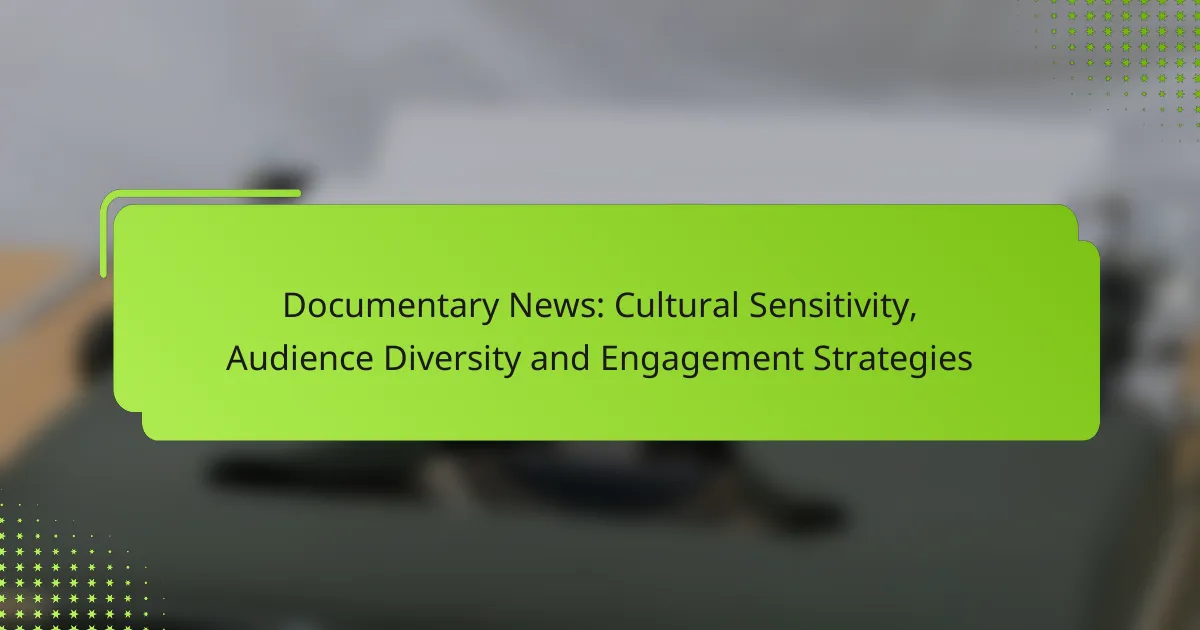User-generated content (UGC) is revolutionizing documentary news by empowering individuals to share their unique experiences and insights, thereby enhancing the authenticity of stories. Coupled with advanced production techniques such as mobile journalism and virtual reality, these developments create more engaging and immersive content. Furthermore, audience involvement plays a crucial role in shaping narratives, fostering a collaborative environment that enriches storytelling and builds community among viewers.

How is user-generated content transforming documentary news?
User-generated content (UGC) is significantly changing documentary news by allowing everyday individuals to contribute their experiences and insights. This shift enhances the authenticity and relatability of news stories, making them more engaging for audiences.
Increased audience engagement
User-generated content fosters greater audience engagement by inviting viewers to participate in the storytelling process. Platforms that encourage submissions can create a sense of community, where users feel their voices matter and can influence narratives.
For example, news outlets may host contests for the best user-submitted videos or photos related to current events. This not only boosts interaction but also encourages users to share content across their social networks, amplifying reach.
Diverse perspectives and stories
User-generated content brings a wealth of diverse perspectives and stories that traditional documentary news may overlook. By incorporating contributions from various demographics, news organizations can present a more comprehensive view of events.
This diversity can highlight underrepresented voices, such as those from marginalized communities, leading to richer and more nuanced storytelling. For instance, a documentary on climate change can benefit from firsthand accounts of local impacts shared by residents directly affected.
Real-time reporting capabilities
User-generated content enhances real-time reporting capabilities, allowing news organizations to quickly gather and disseminate information as events unfold. This immediacy can be crucial during breaking news situations, where timely updates are essential.
News outlets can leverage social media platforms to source live updates and footage from users on the ground. This approach not only speeds up reporting but also provides authentic insights that may not be captured by traditional journalists in the field.

What production techniques enhance documentary news?
Production techniques that enhance documentary news include the use of mobile journalism tools, advanced editing software, and innovative storytelling methods like virtual reality. These techniques improve the quality and engagement of documentary content, making it more accessible and immersive for audiences.
Mobile journalism tools
Mobile journalism tools empower reporters to capture high-quality video and audio directly from their smartphones or tablets. Devices such as gimbals, external microphones, and portable lighting can significantly enhance the production quality without the need for bulky equipment.
For instance, using a smartphone with a good camera and a stabilizer can allow journalists to produce professional-looking footage in various environments. Additionally, apps for live streaming and editing can streamline the workflow, enabling quicker turnaround times for news stories.
Editing software like Adobe Premiere Pro
Editing software like Adobe Premiere Pro is essential for refining documentary news footage. This software offers a range of features, including multi-track editing, color correction, and audio mixing, which are crucial for creating polished final products.
When using Premiere Pro, editors should focus on maintaining a coherent narrative flow and ensuring that audio levels are balanced. Familiarity with keyboard shortcuts can also enhance efficiency during the editing process, allowing for quicker adjustments and rendering times.
Virtual reality storytelling
Virtual reality (VR) storytelling provides an immersive experience that can transport viewers directly into the narrative. This technique allows audiences to explore environments and situations in a way that traditional media cannot, fostering a deeper emotional connection to the subject matter.
To effectively use VR in documentary news, creators should consider the viewer’s perspective and design interactive elements that enhance engagement. Additionally, ensuring high-quality visuals and sound is critical, as poor production can detract from the immersive experience.

How does audience involvement shape documentary narratives?
Audience involvement significantly influences documentary narratives by integrating viewer perspectives and experiences into storytelling. This collaborative approach enriches the content, making it more relatable and diverse, while also fostering a sense of community among viewers.
Interactive platforms like StoryMapJS
Interactive platforms such as StoryMapJS allow audiences to engage with documentaries in a dynamic way. These tools enable users to create and share their own narratives, often incorporating multimedia elements like maps, images, and videos. By allowing viewers to contribute their own stories, filmmakers can gather diverse insights that enhance the overall narrative.
When using StoryMapJS, consider the ease of navigation and the clarity of the interface. A well-structured project can lead to higher engagement rates, as users are more likely to explore and share content that is visually appealing and easy to understand.
Crowdsourced funding via Kickstarter
Crowdsourced funding platforms like Kickstarter empower audiences to financially support documentary projects they are passionate about. This model not only provides necessary funds but also creates a vested interest among backers, who often feel a personal connection to the project. Documentaries that successfully leverage this funding model can benefit from increased visibility and community support.
When launching a Kickstarter campaign, it’s crucial to clearly communicate the project’s vision and goals. Offering tiered rewards can incentivize contributions, with options ranging from digital downloads to exclusive behind-the-scenes access. Aim for a funding goal that reflects realistic production costs to attract potential backers.
Social media feedback loops
Social media platforms create feedback loops that allow audiences to share their thoughts and reactions to documentaries in real-time. This immediate interaction can shape how filmmakers approach their narratives, as viewer feedback can highlight areas of interest or concern. Engaging with audiences on platforms like Twitter or Instagram can foster a dialogue that enhances the documentary’s relevance.
To effectively utilize social media feedback, filmmakers should actively monitor comments and discussions related to their work. Responding to audience input can build a loyal following and encourage further engagement. However, it’s important to balance audience feedback with the original vision to maintain the documentary’s integrity.

What are the best practices for integrating user-generated content?
Integrating user-generated content (UGC) effectively involves establishing clear guidelines, ensuring authenticity, and utilizing moderation tools. These practices help maintain quality and trust while engaging audiences in meaningful ways.
Establishing clear guidelines
Clear guidelines are essential for encouraging user-generated content that aligns with your brand’s values and objectives. Define what types of content are acceptable, including themes, formats, and submission processes.
For example, if your documentary focuses on environmental issues, specify that submissions should relate to sustainability efforts or personal experiences with nature. Providing examples of desired content can further clarify expectations.
Ensuring content authenticity
Authenticity is crucial for maintaining credibility with your audience. Verify that user-generated content is original and accurately represents the contributor’s experiences or opinions.
Consider implementing a verification process, such as requiring users to provide context or background information about their submissions. This not only enhances trust but also enriches the content’s narrative.
Utilizing content moderation tools
Content moderation tools help manage and filter user submissions effectively. These tools can automatically flag inappropriate content, ensuring that only suitable material is showcased.
Utilize a combination of automated systems and human review to strike a balance between efficiency and quality control. Regularly update your moderation criteria to adapt to changing community standards and expectations.

How do production techniques vary across different regions?
Production techniques for documentaries differ significantly across regions due to cultural, technological, and economic factors. These variations influence storytelling methods, equipment used, and audience engagement strategies.
Local storytelling approaches in Europe
European documentaries often emphasize personal narratives and social issues, reflecting diverse cultural backgrounds. Filmmakers frequently utilize observational techniques, allowing subjects to express their stories organically without heavy scripting.
In countries like France and Germany, there is a strong tradition of art-house documentaries that prioritize aesthetics and experimental formats. This can lead to unique visual storytelling that challenges conventional narrative structures.
Documentary styles in North America
North American documentaries tend to focus on a mix of investigative journalism and character-driven stories. Filmmakers often employ a more structured approach, using clear narratives to engage audiences while addressing broader societal themes.
In the United States, the use of high production values and technology is common, with filmmakers frequently incorporating advanced editing techniques and visual effects. This can enhance storytelling but may also lead to a more commercial feel, sometimes overshadowing the subject matter.
Cultural influences on production in Asia
In Asia, cultural influences heavily shape documentary production techniques, with filmmakers often blending traditional storytelling methods with modern technology. For instance, in countries like Japan and India, documentaries may incorporate local folklore and customs, creating a rich narrative tapestry.
Additionally, the regulatory environment can impact production styles. In some regions, filmmakers must navigate strict censorship laws, which can limit creative expression but also encourage innovative storytelling approaches to convey messages subtly.

What are the challenges of audience involvement in documentary news?
Audience involvement in documentary news presents several challenges, primarily related to maintaining quality, ethical standards, and the balance between professional and user-generated content. These factors can significantly impact the credibility and effectiveness of the documentary narrative.
Quality control issues
Quality control is a major concern when incorporating audience-generated content into documentary news. User submissions can vary widely in quality, from well-produced footage to poorly captured clips, which can dilute the overall impact of the documentary. Establishing clear guidelines for submissions can help mitigate these issues.
Documentary producers should implement a vetting process to assess the quality of user-generated content. This can include reviewing technical aspects such as resolution, sound quality, and storytelling coherence. A simple checklist can streamline this process, ensuring that only the best content is included.
Ethical considerations in content use
Ethical considerations are paramount when utilizing audience-generated content in documentary news. Producers must navigate issues such as consent, copyright, and the potential for misrepresentation. Ensuring that contributors fully understand how their content will be used is essential to maintaining trust and transparency.
Documentary makers should obtain explicit permission from contributors and clarify the intended use of their material. Additionally, it’s important to credit contributors appropriately, which not only respects their rights but also encourages future participation.
Balancing professional and user-generated content
Finding the right balance between professional and user-generated content is crucial for maintaining credibility in documentary news. While user-generated content can provide unique perspectives, it must complement professionally produced material to ensure a cohesive narrative. Striking this balance can enhance viewer engagement without compromising quality.
Producers should consider using user-generated content as supplementary material rather than the primary focus. This approach allows for a richer storytelling experience while maintaining the high standards expected of professional documentaries. Regularly assessing audience feedback can also guide adjustments in content balance, ensuring that the documentary resonates with viewers.



